

Table of contents
- Digression into biology simplifies care
- location in summer
- substrate
- Pour
- Fertilize
- Hibernation outdoors
- Hibernation behind glass
- Cut
- repot
- multiply
- Common diseases
- pests
- Conclusion
With its rustic, gnarled shape and evergreen crown, the olive tree celebrates Mediterranean serenity on balconies and patios. Since the magical ornamental and fruit tree of the Mediterranean does not belong to the natural flora of Central European regions, it is mainly cultivated in pots and tubs. Here it is important to take into account the special demands on care. This green guide guides you through the species-compliant care program in a practice-oriented manner. From the ideal location and the balanced water and nutrient balance to pruning and successful overwintering, all aspects are examined in detail.
Digression into biology simplifies care
Before you dive into the proper olive tree care routine, we recommend that you familiarize yourself a little with its biology. Cultivation in pots and tubs is all the easier for you.
The evergreen olive tree is native to the entire Mediterranean region, where it has been cultivated as a crop for many thousands of years. The typical Mediterranean climate prevails in its habitats with annual mean temperatures of around 20 degrees Celsius. Its distribution areas are characterized by drought, because the annual precipitation oscillates around 500 mm. In comparison, the average annual temperature in Germany is around 10 degrees Celsius with precipitation of 800 mm to 1,000 mm. It is characteristic of the olive that summer heat of 40 degrees Celsius has no negative effects, while temperatures around the freezing point have a significant impact on the tree.
Under the influence of the Mediterranean climate, the olive tree has developed the following growth behavior:
- A dense crown of evergreen leaves that are silvery hairy beneath
- Terminal and lateral flower panicles with a length of 2 to 4 cm
- Cream-white to yellowish flowers, mostly hermaphroditic, rarely unisexual
- Flowering time between mid/end of April to mid/end of June
- Solitary drupes in autumn
- Up to 7 m deep, branched root system
When young, the olive tree has a smooth, greenish-grey bark. With increasing age, the unmistakable, gnarled, cracked trunk develops, which can take on bizarre shapes. In the course of its long evolution, the true olive tree has adapted so well that it can reach a very old age in its homeland. One of the oldest specimens is on Crete and is estimated to be more than 4,000 years old.
location in summer
The olive tree is not suitable for year-round cultivation in living rooms or heated conservatories. The tree develops its optimum in an open-air location to enjoy the unfiltered rays of the sun and fresh air. When the meteorologists forecast in spring that the night-time temperatures will no longer fall below - 10 degrees Celsius, your exotic wood takes a location with the following general conditions a:
- Full sun with at least 4 to 6 hours of sunshine
- Gladly in front of the south wall of the house or on the south-facing balcony
- Ideally protected from wind and rain

Wet, cold weather in spring can damage your olive even if the temperature is just around freezing. In this case, please wait until dry spring weather prevails. On the other hand, there is no cause for concern if the summer comes with temperatures of 35 degrees and higher and the heat builds up at lunchtime.
Tip:
Before an olive tree takes up its position in full sun, it should acclimate for 8 to 10 days in a partially shaded place. Suddenly exposed to direct sun, the evergreen leaves suffer sunburn. The resulting light brown spots spoil the pretty foliage throughout the summer.
substrate
In a pot, an olive tree naturally cannot develop the expansive and deep root system. The quality of the substrate is therefore of particular importance. In addition to the supply of nutrients, water and oxygen, the perfect soil offers the roots reliable stability without compaction. Conventional potting soil does not come close to meeting these requirements. Special substrates for olives from specialist shops have the right composition, but are quite expensive. Alternatively, mix the potting soil yourself, which consists of these components:
- Well matured garden compost
- Optional bark humus from the store
- Clay garden soil or natural clay
- coconut or wood fibers
- Garden, algae or dolomite lime
- Expanded clay, lava granules, sand or fine-grained chippings
You will look in vain for the ultimate recipe for the perfect mixing ratio. Numerous recommendations circulate among olive gardeners, from which you will develop your personal recipe over the years. A mix of 35 percent loam and compost, 20 percent wood or coconut fibers and 10 percent activated lime and quartz sand is generally accepted.
This composition signals a lime tolerance that is unusual for Mediterranean plants. In fact, a pH value between 7 and 8 is one of the key criteria for vital growth of your Olea europaea. Unfortunately, it is a common misconception to equate olive and lemon trees in this regard. Therefore, do not buy citrus soil when you buy it, as it is designed for a pH between 5.5 and 6.5, which is not good for your olive tree.
Pour
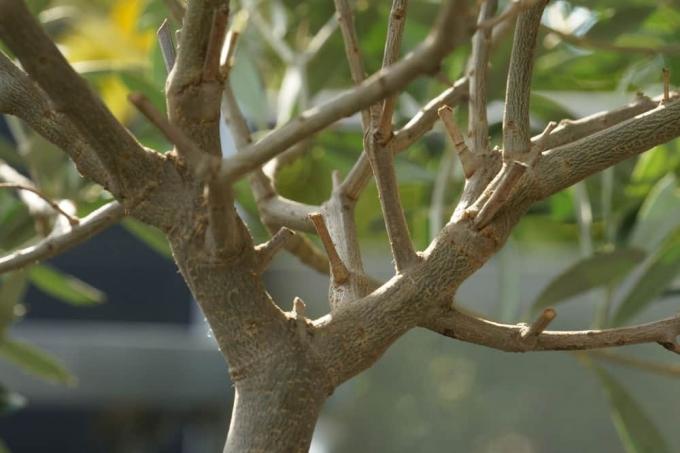
The special demands on the care in the pot are expressed in the fact that the water supply differs significantly from planted olive trees. The moisture in the substrate evaporates quickly in a warm, full sun. While in the bed the natural rainfall is usually sufficient and the root system up to 7 m deep If necessary, the groundwater compensates for this, an olive in the bucket is to be watered regularly reliant. How to do it right:
- The aim is a periodically moist potting soil with an interim drying phase
- Water thoroughly when the substrate surface has dried
- Let the water run out of the can spout until the soil on the bottom of the pot is damp
Only water the olive tree again when the finger test indicates that the soil has dried up to a depth of 1 to 2 cm. This procedure ensures that no waterlogging can form, which is life-threatening for every olive tree. Please use normal tap water, but not directly from the tap when it is still ice cold.
Tip:
With a moisture meter you have a valuable tool in your hands to water your olive tree as needed. If the measuring stick is inserted into the substrate, a scale clearly shows whether the root ball is dry, semi-dry or wet.
Fertilize
As long as an olive tree is growing, flowering and fruiting, it needs additional nutrients in the tub. Since the supplies in the substrate are limited, the application of fertilizer begins 6 weeks after potting or repotting. Its special care requirements require the use of special preparations for Mediterranean plants, such as Compo Mediterranean plant fertilizer, olive fertilizer high-tech Olea from Green24 or Chrystal fertilizer sticks Mediterranean Plant. Conventional complete fertilizers such as Blaukorn or Entec are not recommended for olives. The ideal nutrient intake is as follows:
- Fertilize the olive tree from March to September
- Add a liquid olive fertilizer to the irrigation water once a week
- Alternatively, press fertilizer sticks into the substrate in March, May and July
- Optionally apply a long-term fertilizer for Mediterranean plants in March and June
From September to February, stop feeding, because an olive tree hardly uses any energy during this time. So that the nutrient salts contained in the fertilizer do not cause burns to the roots, please water with clear water before and after administration.
Tip:
In the ecologically cultivated Mediterranean garden, cover the nutrient requirements of your olive tree in the bucket with a liquid organic fertilizer. The high-quality Biobest organic earthworm fertilizer, which you add to the irrigation water every 8 to 10 days from March to September, is excellently suited.
Hibernation outdoors
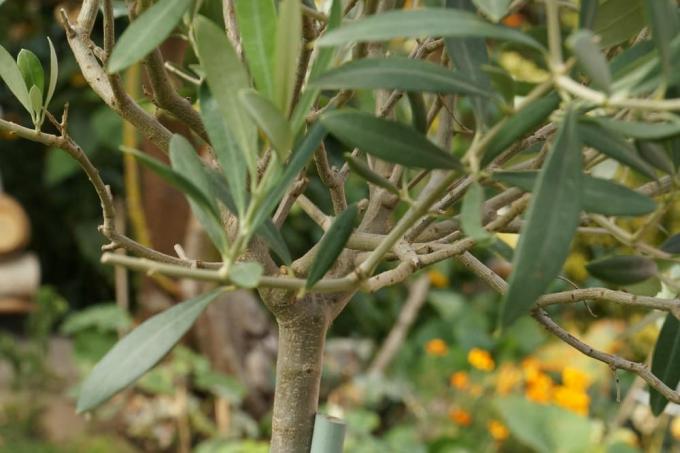
Designing the framework conditions for an olive tree in a tub so that it survives the tricky winter season is a particular challenge. This is all the more true if overwintering outdoors is an option because the garden is within hardiness zone Z8. These include the wine-growing regions, the Lower Rhine and other regions where the minimum winter temperature is -10 degrees Celsius. How to overcome the hurdle of overwintering in a pot under the open sky:
- Place a large wooden box on a plant trolley in front of a house wall or in a wall niche
- Lay a thick layer of bark mulch on the bottom of the box
- Place the pot in the middle and stuff it all around with straw
- Cover the substrate with leaves, straw, sawdust or wood shavings
- Alternatively, fill in bark mulch up to the edge of the bucket and on the substrate
- The olive crown encase with breathable and translucent fleece
The closer the olive tree in the bucket is to a house wall, the more it benefits from the waste heat there during the winter. Ideally, the winter pitch is also protected from moisture by a canopy. If the solution with the wooden box cannot be implemented, the pot is given a thick winter coat made of several layers of fleece or foil.
Care during the winter in the garden or on the balcony is limited to moderate watering. Despite the dormancy, the evergreen leaves continue to release moisture. Therefore, water on frost-free days to avoid dry bulbs.
Hibernation behind glass
Where winter is accompanied by severe frost, hibernation requires quarters behind glass. Of course, this does not mean a well-heated living room, since complete leaf loss is unavoidable here. Rather, your olive tree wants a bright, frost-free location with temperatures up to a maximum of 10 degrees Celsius. The bucket is only cleared when the mercury column falls below – 5 degrees Celsius at night. Some time under the influence of winter cold starts the flowering induction for the next season and thus promotes a rich olive harvest. This is how you conduct your noble tree healthy and lively through the winter time:
- Continue to water moderately without causing waterlogging
- Do not fertilize from October to February
- Ventilate the wintering room every 2 to 3 days without creating a cold draft
An unheated conservatory, a bright garage or a cool, light-flooded stairwell are shortlisted as winter quarters. If it is unavoidable that the temperatures rise above 10 degrees Celsius, a plant or daylight lamp compensates for the increased light requirement. On the other hand, if you banish your olive to the dark boiler room, this is by far the most problematic option for overwintering. Even experts cannot predict to what extent the resulting leaf shedding will be compensated for next spring and summer.
Cut
The very slow growth requires a well-planned cut. In order for your olive tree to retain its well-formed and densely leafed crown, pruning is not part of the care program every year. Therefore, in April and May, give your olive a thorough examination to decide whether pruning is necessary. Only reach for the scissors when the tree is bare from the inside, long shoots are growing out of shape or frost damage has occurred to the branches. The best time for a shape and maintenance cut is an overcast day just before the new shoots. With this cut you can:
- In the first step, thin out the crown by removing dead branches
- Shorten branches that are too long until just before a bud or a leaf node
- First cut the leading branches and then shorten their side branches a little more
- Cut off the shoots on the branch below the crown on the trunk
- Cut back frozen or diseased branches to healthy wood
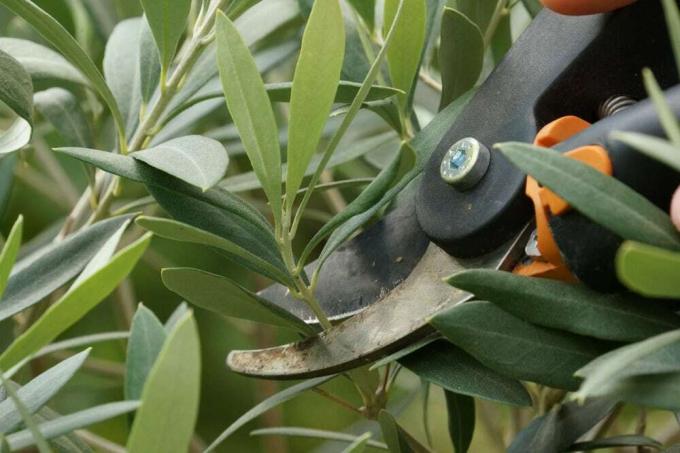
Repeatedly step back a few steps to plan the rest of the incision. The leisurely growth rate will only close up any holes that have formed very slowly. Therefore, cut in small stages or, if in doubt, leave the scissors alone. Please note that leafless branches are not necessarily dead. Before you remove a vital shoot, wait until early summer. Cut off the dead part only when there are actually no new leaves.
repot
The crown and root ball of a lovingly tended olive tree grow proportionally to each other. This means that every 2 to 3 years the pot volume is no longer sufficient for the roots and thus the crown to develop unhindered. Furthermore, after some time the substrate is so exhausted that even regular fertilization no longer covers the energy requirement. If the bucket is tight or if the first roots are looking for a way through the opening in the bottom, repot your olive between February and May. The new pot is so large that there is room for two fingers between the root ball and the pot wall. Here’s how to do it professionally, step by step:
- Use a knife to loosen the edges of the root ball from the edge of the bucket
- Lay the olive tree on its side, grasp at the base of the trunk and pull out
- Shake the root ball vigorously and loosen it up with both hands
- Lay a 3-5 cm high drainage on the bottom of the pot made of potsherds or grit
- Lay an air- and water-permeable fleece over it
Now measure how high the lower substrate layer has to be so that later the root disc is about 3 cm below the edge of the pot. Fill in the recommended substrate, place the root ball in the middle and fill in the cavities. Intermittent pressing of the fresh soil prevents gaps from forming, which prevent rapid rooting. In the last step, pour thoroughly. The repotted olive tree stays in the semi-shady location for the next 8 days to regenerate.
multiply
For the propagation of olive trees we recommend the cuttings method. This procedure is so practical and promising that it is also favored in the large olive plantations. At the beginning of the vegetation phase, cut 10 cm long top cuttings from one-year-old shoots, provided that the pruning does not already provide the appropriate material in the form of clippings. Proceed as follows.
- Fill a propagation tray with coconut fiber substrate and press down
- Cut each cutting at a slight angle 8 to 10 mm below a leaf
- Defoliate half of the cutting
- Dip the interface in a rooting powder
- Stick two-thirds of the offshoots into the ground, 2 to 3 cm apart
- Spray cuttings and soil with water
- Place the tray in a heated indoor greenhouse
A combination of high humidity and temperatures around 30 degrees Celsius is important for rooting olive cuttings. Air the mini greenhouse daily and spray the offshoots with room-warm water when the substrate has dried. The cuttings can only clear the mini greenhouse when a fresh shoot appears, because now normal room temperatures are sufficient for further growth.
Common diseases
An olive tree is susceptible to eyespot disease, which is caused by the fungal pathogen Spilocaea oleagina. Symptoms of infection are dark spots with a light halo that spread over the entire leaf, causing it to die. Persistently remove each diseased leaf, at the early stage of infestation, deprive the fungal spores of the possibility of further spread. If more than half of the crown is infected, control the disease with a copper-based fungicide such as Atempo Pilzfrei or Cueva Pilz-frei von Neudorff.

With olive canker, you are dealing with a hardened bacterium that penetrates the interior of the plant through the smallest of wounds in the bark. In addition to brown discoloration, cracks on the bark and dark red lesions, this disease manifests itself as cancerous growths. So far, no effective means of control are available. Diseased parts of the plant should be cut out and burned. Preventive measures are a rain-protected location, no overhead irrigation and meticulous disinfection of cutting tools.
pests
Wintering that is too warm weakens your olive tree in the tub considerably and attracts scale insects of all kinds. Signs of an infestation are small bumps on the leaves caused by scale insects or white cotton balls caused by mealybugs and mealybugs. Since the pests are after the plant sap, their activities must be stopped. An effective way to combat lice is to wipe the leaves with a soft cloth soaked in alcohol. Dusting with diatomaceous earth dissolves scale insect shells and dries out the insects underneath.
Conclusion
An olive tree in pots and tubs only lives up to its reputation as a Mediterranean symbol of longevity if care takes its special requirements into account. A sunny, warm location in summer and a bright, cool place in winter set the course. A needs-based water and nutrient balance, tailored to the season, rounds off the annual care program. At intervals of 2 to 3 years, a shape and maintenance cut as well as a change to a larger pot are on the agenda in spring. With all care measures, the subliminal fact always resonates that a real olive tree is in its claims from other Mediterranean plants, such as lemons or oranges, in many respects differs. If the requirements of this guide are met, diseases and pests have little chance of infestation.
 garden editorial
garden editorial I write about everything that interests me in my garden.
Learn more about Baumlexikon
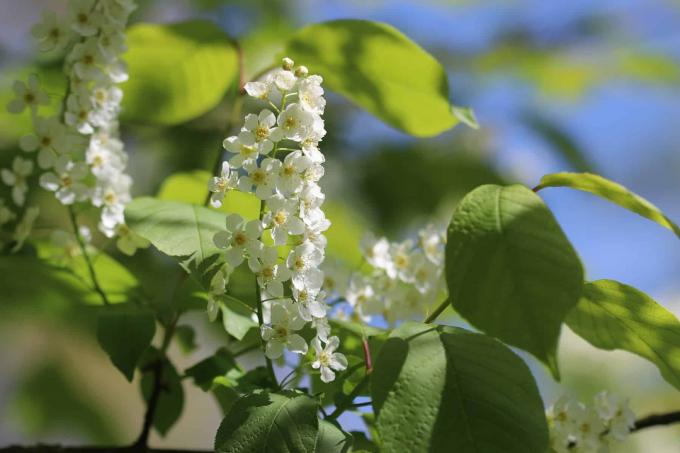
Bird cherry, Prunus padus: caring for, pruning & propagating
The bird cherry is a shrub or tree that is the ideal bee pasture in a natural garden. However, the plant should also be viewed with caution, as it is a poisonous plant for horses. Nevertheless, it is popular in the local colorful hedges.
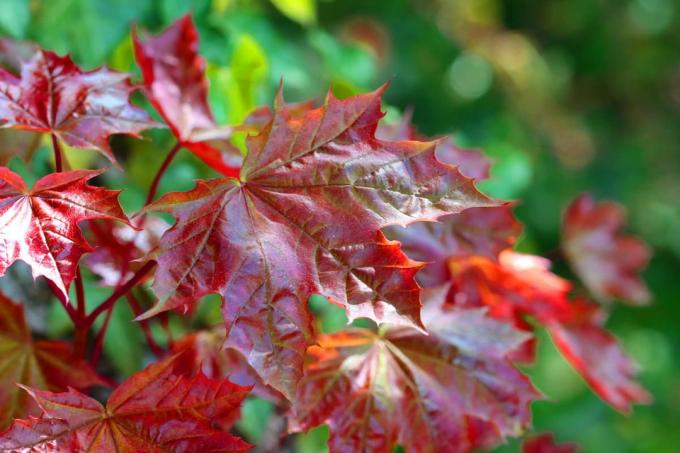
Red maple: 9 tips for caring for, cutting & overwintering
The red maple is one of the most impressive trees in Germany due to its unusual scarlet leaf colour. Here you can find out how to integrate this impressive plant into your garden and how to keep it healthy and vigorous.

Sycamore tree: Properly care for and cut sycamore trees
The plane tree (Platanus) has a high decorative value. In terms of care, it is mostly undemanding, which is why it is often chosen as a street tree. Nevertheless, there are a few details to be observed when it comes to care, as described in the home garden guide.

Birch locations: 5 important criteria
Birch trees are extremely frugal trees and are particularly eye-catching and decorative thanks to their light-colored bark. When choosing a location, however, a few factors should be considered in order to create optimal conditions for their growth and to protect the environment.

Cutting dwarf pine - instructions for the perfect cut
Dwarf pines can be pruned by thinning out, topiary or limbing. A bonsai design with needle and root pruning is also possible. So that the wood does not look unattractive after the pruning measure, a few rules of technology should be observed.

Is the vinegar tree poisonous? | Who is it dangerous for?
In ornamental gardens, the vinegar tree is an attractive eye-catcher due to its unusual flowers and the appealing autumn color of its feathered leaves. The red, upright fruit cobs (flowers) are responsible for the striking appearance. Despite everything, the vinegar tree is not an unproblematic tree.
